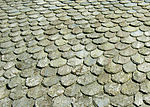Olette
|
Olette Oleta |
||
|---|---|---|

|
|
|
| region | Occitania | |
| Department | Pyrénées-Orientales | |
| Arrondissement | Prades | |
| Canton | Les Pyrénées Catalanes | |
| Community association | Conflent-Canigó | |
| Coordinates | 42 ° 33 ' N , 2 ° 16' E | |
| height | 563-2,361 m | |
| surface | 28.95 km 2 | |
| Residents | 364 (January 1, 2017) | |
| Population density | 13 inhabitants / km 2 | |
| Post Code | 66360 | |
| INSEE code | 66125 | |
 The historic district of Évol of Olette |
||
Olette (on Catalan Oleta ) is a French commune of the department of Pyrénées-Orientales in the region Occitania . Administratively it is assigned to the Prades arrondissement . Olette belongs to the canton of Les Pyrénées Catalanes .
The municipality now also includes the historic district of Évol , which was a politically independent municipality until 1827. This Évol is classified as one of the Plus beaux villages de France ( Most Beautiful Villages in France ).
geography
The southern French mountain village with 364 inhabitants (as of January 1, 2017) is at a good 600 meters and is located in the Conflent on the left bank of the Têt . A reception point for access to the Regional Natural Park of the Pyrénées Catalanes has been set up in the municipality . The place can be reached from the city of Perpignan , which is 53 kilometers east, via the national route N116.
Two kilometers northwest of the center of the village of Olette, above the valley of the river Évol at 985 meters, the district of Évol, which is sometimes referred to as the "balcony of Olette", towers 300 meters higher. It is the historically most interesting part of the municipality. There you will find old houses whose masonry is typical of the area and made of slate ( schiste ) and whose roof trusses are covered with slate ( lauzes ).
The 1,861 meter high Coll de la Llose mountain pass leads from Olette into the Haut-Conflent (a popular cross-country ski area in winter) and ends in the village of La Llagonne .
Olette is served by the Ligne de Cerdagne narrow-gauge railway that connects Villefranche-de-Conflent with Enveitg . The train that runs on this route is often called Le canari (canary bird) by the local population because of its striking yellow paintwork . The mountain railway has become a tourist magnet. The travel time for the entire route (63 kilometers) is just under three hours.
history
The castle of Évol ( French Château d'Évol ) was built in 1260 by Guillaume de So (also called Guillem de So ). In 1137, Évol was elevated to a vice-county status within the historic province of Cerdanya . In 1550 a Catalan forge was set up in Évol . In 1827, Évol was incorporated by Olette.
Population development
| year | 1962 | 1968 | 1975 | 1982 | 1990 | 1999 | 2009 |
|---|---|---|---|---|---|---|---|
| Residents | 616 | 680 | 544 | 532 | 447 | 345 | 389 |
Attractions
- The Église Saint-André church in Évol dates back to the 11th century and was modernized in the 18th century. The sacred building has been a French cultural monument since 1943 .
- The ruins of the Château d'Évol castle date back to 1260. Only a tower and some wall remains have been preserved. The fortification has been a French cultural monument since 1982.
- Bastide d'Olette is the name of an old, typically Provencal house, which is now the reception point for the nearby nature park. The building has been a French cultural monument since 1927.
- The chapel Chapelle Saint-Étienne in Évol from the 14th century was reconstructed in the 18th century.
- The folk art museum Musée des Arts et Traditions populaires is also located in Évol .
Web links
Individual evidence
- ↑ Évol on Les plus Beaux Villages de France (French)
- ↑ Bulletin de la Société agricole, scientifique & littéraire des Pyrénées-Orientales , Volume 11. Imprimerie de J.-B. Alzine, Perpignan 1858, p. 503 ff.
- ↑ Entry no. PA00104059 in the Base Mérimée of the French Ministry of Culture (French)
- ↑ Entry no. PA00104058 in the Base Mérimée of the French Ministry of Culture (French)
- ↑ Entry no. PA00104057 in the Base Mérimée of the French Ministry of Culture (French)


